
The NWA World's Heavyweight Championship is a men's professional wrestling world heavyweight championship owned and promoted by the National Wrestling Alliance (NWA), an American professional wrestling promotion.
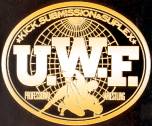
The original Japanese-based Universal Wrestling Federation (UWF) was a Japanese professional wrestling promotion from 1984 to 1986, formed by wrestlers who had left New Japan Pro-Wrestling. It was a pioneer in shoot-style wrestling, which emphasized legitimate techniques and realism. It was revived as the Newborn UWF in 1988. Newborn UWF lasted until 1990. It was revived again in 1991 as Union of Wrestling Forces International (UWF International or UWFi), which in turn lasted until 1996.

Kingdom, or Kingdom Professional Wrestling, was a Japanese shoot style professional wrestling promotion that held events in 1997 and 1998. It was considered a continuation of UWF International, having most of its former roster: Nobuhiko Takada, Yoji Anjo, Kazushi Sakuraba, Daijiro Matsui, Naoki Sano, Masahito Kakihara, Yoshihiro Takayama, Kenichi Yamamoto and Hiromitsu Kanehara.
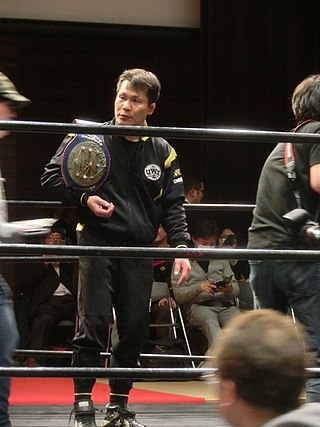
Kiyoshi Tamura is a Japanese retired professional wrestler and mixed martial artist. Once a student of legendary professional wrestlers Billy Robinson, Lou Thesz and Akira Maeda, Tamura was known for his skills in catch wrestling and is considered to be one of the greatest shoot wrestlers of all time. Competing exclusively in shoot style wrestling, Tamura began his career with UWF Newborn and later joined its successor group UWF International before transitioning to mixed martial arts.
Shoot wrestling is a Japanese hybrid grappling style and combat sport. Shoot wrestling incorporates techniques from various wrestling, submission grappling, kickboxing and karate styles. It was particularly inspired and influenced by catch wrestling, a form of wrestling with submissions that was the predominant style of professional wrestling in the 19th and early 20th century, at the time a competitive sport and not yet predetermined.

Akira Maeda is a Japanese mixed martial arts promoter, writer and retired professional wrestler and mixed martial artist. Maeda was also known by the ring name Kwik-kik-Lee during his time on the British wrestling's slot on the sports show World of Sport (WoS). Maeda helped develop the shoot-style of professional wrestling during the late 1980s. He founded Fighting Network RINGS in 1991 which would become one of the top MMA promotions before it folded in 2002.
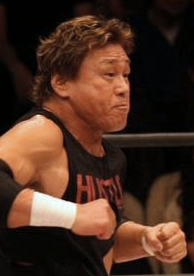
Genichiro Shimada, better known as Genichiro Tenryu is a Japanese retired professional wrestler and professional wrestling promoter. At age 13, he entered sumo wrestling and stayed there for 13 years, after which he turned to Western-style professional wrestling. "Tenryu" was his shikona. He had two stints with All Japan Pro Wrestling (AJPW), where he spent the majority of his career while also promoting Super World of Sports (SWS), Wrestle Association R (WAR) and Tenryu Project. He is widely considered to be one of the greatest professional wrestlers of all time. At the time of his retirement, professional wrestling journalist and historian Dave Meltzer wrote that "one could make a strong case [that Tenryu was] between the fourth and sixth biggest native star" in the history of Japanese professional wrestling.

Yoshiaki Fujiwara is a Japanese professional wrestler, trainer and wrestling promoter. He is famous for his long career in wrestling, having worked in New Japan Pro-Wrestling (NJPW), Pro Wrestling ZERO-ONE (ZERO-ONE), and the two incarnations of shoot style promotion Universal Wrestling Federation. Fujiwara is known for his catch wrestling expertise, having been praised by fighters like Josh Barnett and Ken Shamrock. He was trained by Karl Gotch and has trained many MMA fighters and professional wrestlers. Fujiwara also has a strong background in Judo and Muay Thai.

Yoshihiro Takayama is a Japanese former professional wrestler and mixed martial artist. Debuting for UWF International (UWFI) in the 1990s, Takayama joined All Japan Pro Wrestling (AJPW) in 1997 after UWF-i folded. In 2000, he joined Pro Wrestling Noah (Noah), and later became a mainstay in New Japan Pro-Wrestling (NJPW) where he arguably achieved his greatest success, holding the IWGP Heavyweight Championship and NWF Heavyweight Championship simultaneously in 2003. He is one of only five men to hold all three puroresu major heavyweight titles, the others being Kensuke Sasaki, Keiji Muto, Satoshi Kojima, and Yuji Nagata.
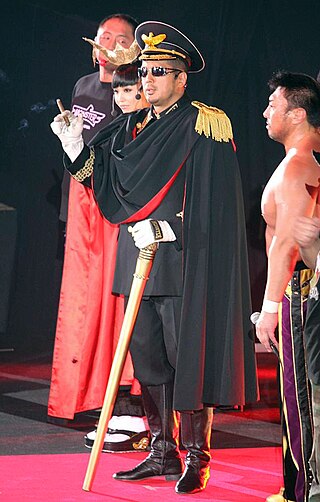
Nobuhiko Takada is a Japanese former mixed martial artist, retired professional wrestler, actor, and writer. He competed in New Japan Pro-Wrestling (NJPW), Universal Wrestling Federation (UWF) and the Union of Wrestling Forces International (UWFI) in the 1980s and 1990s, becoming one of the highest figures of the "shoot-style" movement.

Kazuo Yamazaki is a Japanese retired professional wrestler, wrestling instructor and commentator who is known for his work in New Japan Pro-Wrestling (NJPW), and shoot-style promotions Universal Wrestling Federation (UWF) and UWF International (UWFi). He is signed as a commentator for New Japan Pro-Wrestling (NJPW).
Naoki Sano is a Japanese retired professional wrestler and former mixed martial artist most notable for being the generational rival of legendary Japanese pro wrestler Jushin Liger. During the last years of his career he went by the name Takuma Sano.
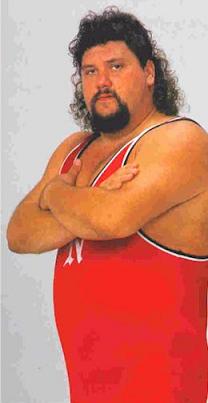
Gary Mitchell Albright was an American professional wrestler best known for his work in Japan, first with UWF International (UWFi), and later All Japan Pro Wrestling (AJPW). In AJPW, Albright was a two-time World Tag Team Champion. Albright was also known for his work with Stampede Wrestling in Canada, under his birth name as well as the ring name Vokhan Singh.

Shiro Koshinaka is a Japanese professional wrestler who has competed in All Japan Pro Wrestling (AJPW), New Japan Pro-Wrestling (NJPW) and Wrestle Association "R" (WAR) during the 1980s and 1990s. He was also the first IWGP Junior Heavyweight Champion.

Thomas Burton was an American professional wrestler, also known by his ring name Tom Davis, who competed in North American regional and independent promotions during the 1980s and early 1990s including the United States Wrestling Association (USWA), Global Wrestling Federation (GWF), the Universal Wrestling Federation (UWF) and the American Wrestling Association (AWA). He also had successful stints in international promotions such as the Japanese shoot-fighting promotion UWF International.

Yoji Anjo is a retired Japanese professional wrestler, mixed martial artist and kickboxer. Anjo is considered to be one of the pioneers of the shoot style movement during the 1980s and early 90s.

Masahito Kakihara is a former Japanese professional wrestler and mixed martial artist, who is known for his work in New Japan Pro-Wrestling (NJPW) and UWF International (UWFI).

Wrestling World 1996 was a professional wrestling event co-produced by the New Japan Pro-Wrestling (NJPW) and UWF International (UWFi) promotions. The event took place on January 4 in the Tokyo Dome. Wrestling World 1996 was the fifth January 4 Tokyo Dome Show held by NJPW. The show drew 54,000 spectators and $5,400,000 in ticket sales.
Shigeo Miyato is a Japanese catch wrestling instructor and retired professional wrestler, best known for his work in Universal Wrestling Federation (UWF) and New Japan Pro Wrestling (NJPW). A former student of legendary wrestlers Billy Robinson and Lou Thesz, Miyato is the founder and head coach at the CACC Snake Pit Japan, which he based on the original Snake Pit in England.
The 1996 Battle Formation was the first Battle Formation event produced by New Japan Pro-Wrestling. The event was held on April 29, 1996 at the Tokyo Dome in Tokyo, Japan. It was a major success with a crowd of estimated 60,000 people and an approximate revenue of $5,700,000 from ticket sales. The event featured competitors from various promotions including Michinoku Pro Wrestling, New Japan Pro-Wrestling, Union of Wrestling Forces International, World Championship Wrestling and Wrestle Association R.














